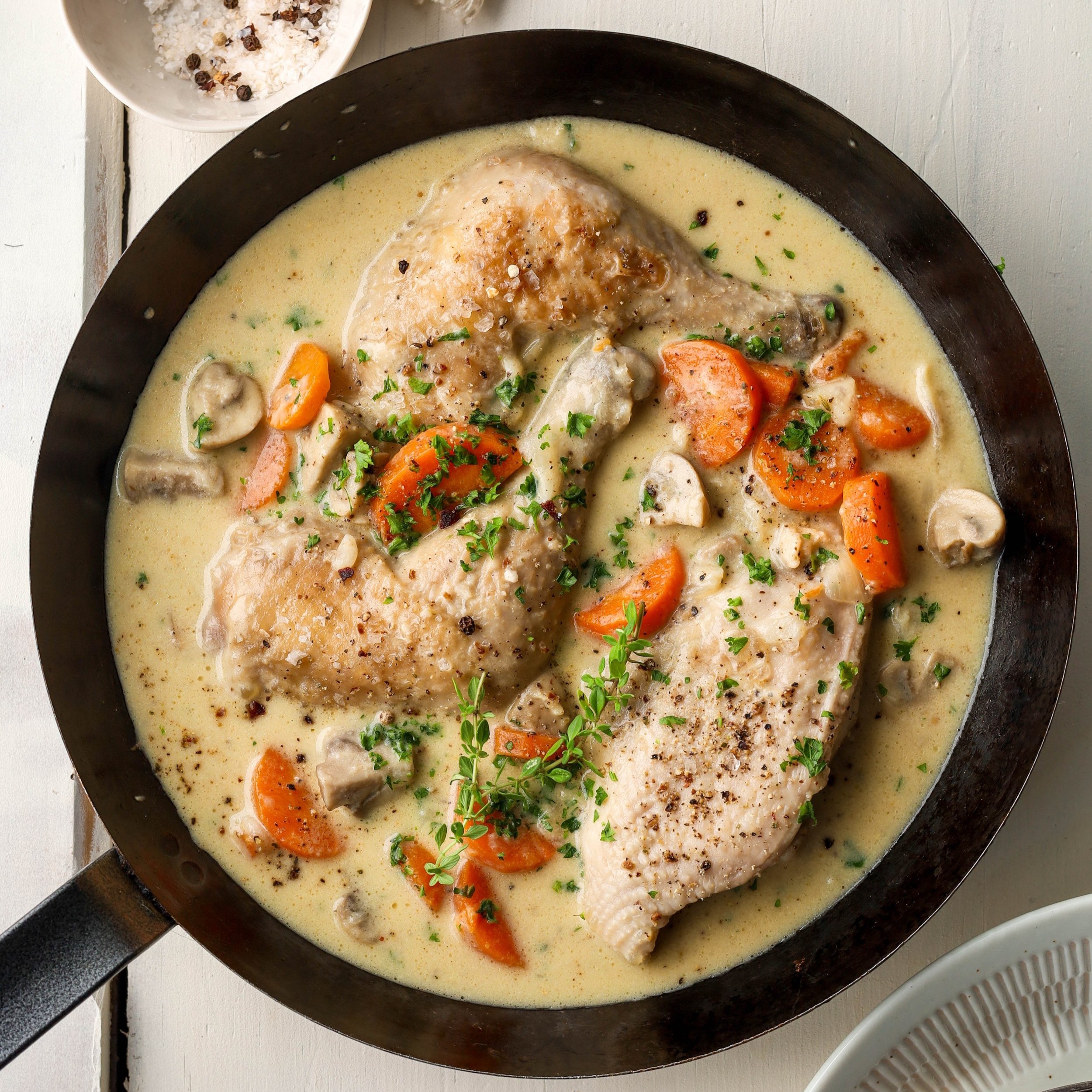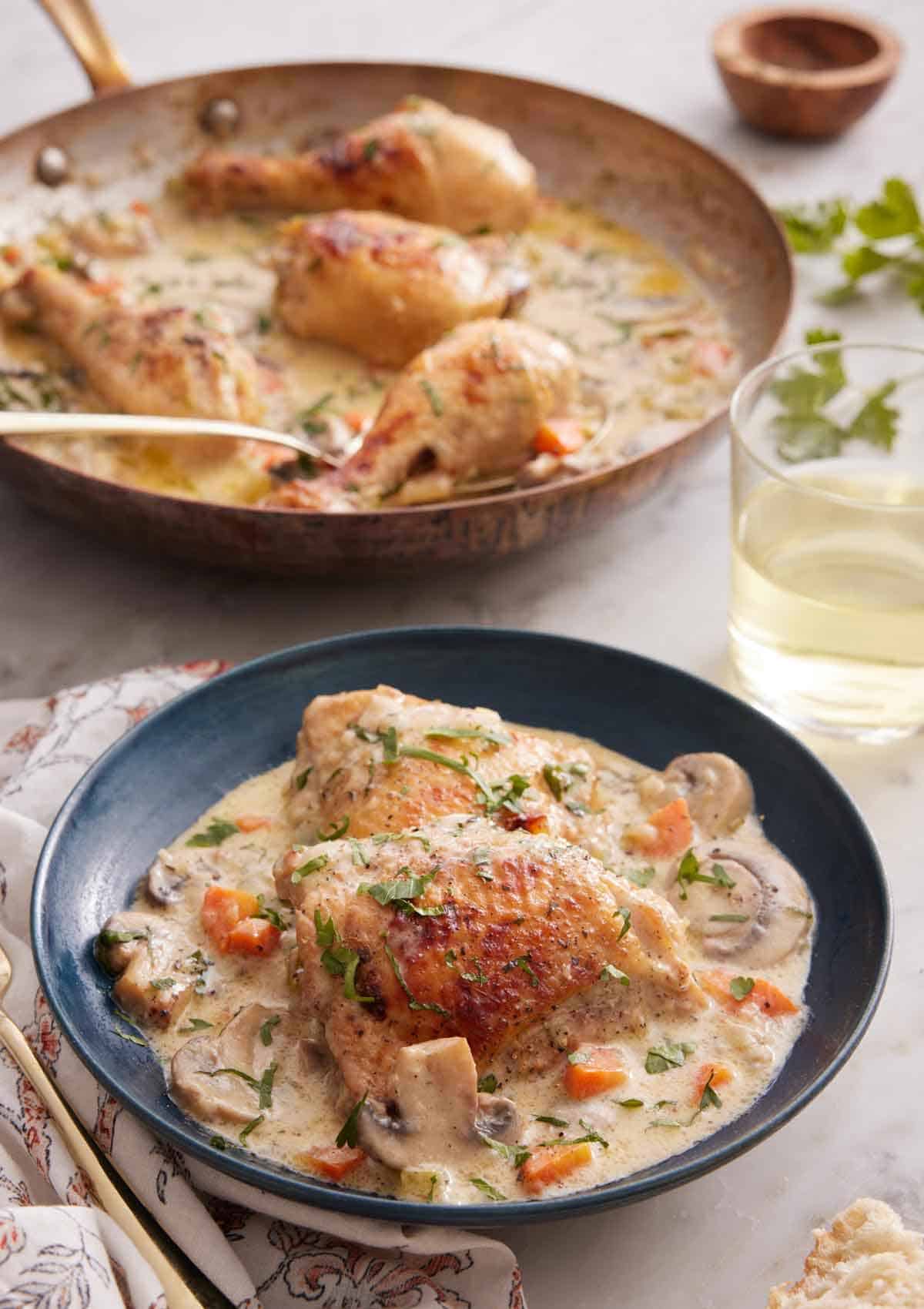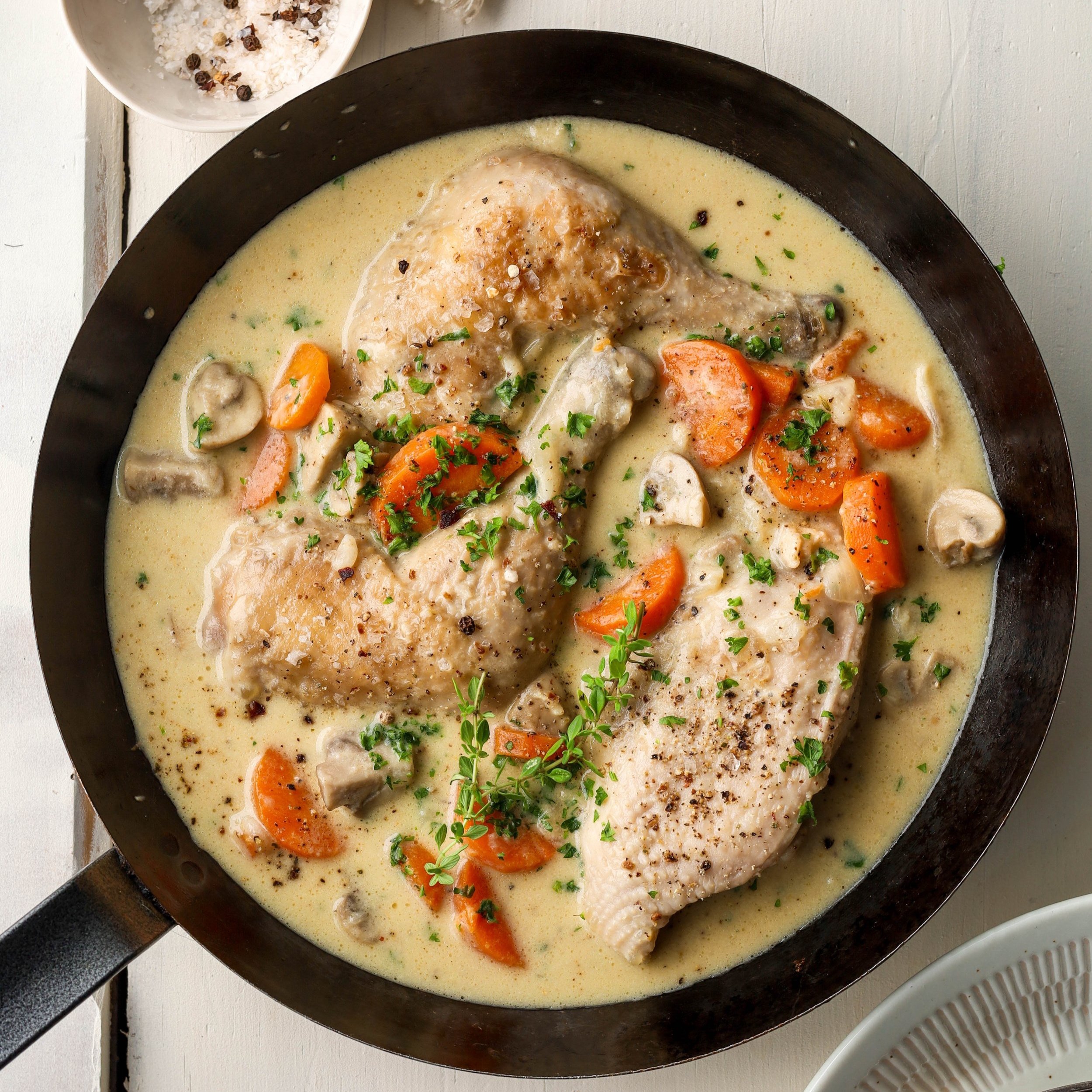Traditional Fricassee Recipes: The 500-Year-Old Cooking Technique You Need to Master
Traditional Fricassee Recipes:

Are you looking to elevate your cooking skills with a technique that has stood the test of time? Look no further than fricassee, a versatile cooking method with roots dating back to medieval France. This classic preparation method—somewhere between a sauté and a stew—has traveled the world and evolved into countless variations while maintaining its distinctive character. In this comprehensive guide, we’ll explore the rich history of fricassee, share traditional recipes from different cultures, and provide step-by-step instructions for creating these comforting dishes in your own kitchen.
Table of Contents
- What is Fricassee? Understanding the Technique
- The Classic French Chicken Fricassee
- Caribbean Twist: Jamaican Chicken Fricassee
- Rustic Variation: Rabbit Fricassee
- Modern Adaptations and Variations
- Tips for Fricassee Success
- Why Fricassee Deserves a Place in Your Cooking Repertoire
- Conclusion
What is Fricassee? Understanding the Technique
Fricassee (pronounced “FRIK-uh-see”) is a cooking method that involves cutting meat into pieces, lightly browning them in fat, then simmering them in a sauce until tender. The word comes from French and is theorized to be a compound of “frire” (to fry) and “casser” (to break into pieces). This technique first appeared in culinary texts as early as the 15th century and was popularized during the reign of Louis XIV.
What makes fricassee distinct from other stewing methods is its specific preparation technique:
- The meat is typically cut into serving pieces
- The pieces are lightly sautéed in fat (traditionally butter) without browning them too much
- A roux-based sauce is created, often enriched with egg yolks and cream
- The meat gently simmers in this sauce until perfectly tender
Food historian Damon Lee Fowler explains that “fricassee is an old French name for a kind of stew that dates back to the late Middle Ages,” making it one of the oldest continuously prepared dishes in Western cuisine. Gainesville Sun
The Classic French Chicken Fricassee

The most iconic version of this dish is the French Chicken Fricassee (Fricassée de Poulet à l’Ancienne), which Julia Child helped popularize in America. This dish features bone-in chicken pieces in a velvety white sauce with mushrooms, pearl onions, and herbs.
Classic French Chicken Fricassee Recipe
Ingredients:
- 3-4 pounds bone-in, skin-on chicken pieces
- 2 tablespoons unsalted butter
- 1 tablespoon olive oil
- 1 large onion, diced
- 2 carrots, sliced
- 2 celery stalks, sliced
- 8 ounces mushrooms, sliced
- 2 cloves garlic, minced
- 2 tablespoons all-purpose flour
- 1 cup dry white wine
- 2 cups chicken stock
- 1 bouquet garni (thyme, parsley, bay leaf)
- 1/2 cup heavy cream
- 2 egg yolks
- 2 tablespoons fresh tarragon, chopped
- Salt and freshly ground black pepper
- 2 tablespoons fresh parsley, chopped
Instructions:
- Prepare the chicken: Season chicken pieces generously with salt and pepper.
- Brown the chicken: In a large Dutch oven, melt butter with olive oil over medium heat. Working in batches, lightly brown the chicken pieces on all sides (about 5 minutes per batch). Remove and set aside.
- Build the sauce base: In the same pot, add onions, carrots, and celery, cooking until softened (about 5-7 minutes). Add mushrooms and garlic, cooking for another 3 minutes.
- Create the roux: Sprinkle flour over vegetables and stir constantly for 2 minutes.
- Add liquids: Slowly pour in white wine, scraping up any browned bits from the bottom of the pot. Bring to a simmer and reduce by half. Add chicken stock and bouquet garni.
- Braise the chicken: Return chicken to the pot, bring to a gentle simmer, cover and cook for 25-30 minutes until chicken is tender and cooked through.
- Finish the sauce: In a small bowl, whisk together cream and egg yolks. Remove pot from heat and slowly stir in the cream mixture (tempering to prevent curdling). Return to low heat (do not boil) and stir until sauce thickens slightly.
- Final seasoning: Remove bouquet garni, stir in tarragon, and adjust seasoning with salt and pepper. Garnish with fresh parsley before serving.
Traditionally, chicken fricassee is served over rice, creamy mashed potatoes, or buttered egg noodles with plenty of crusty bread to soak up the delicious sauce. Martha Stewart
Caribbean Twist: Jamaican Chicken Fricassee

As fricassee techniques traveled the world with European colonization, they were adapted to local ingredients and tastes. One of the most distinctive variations comes from Jamaica, where the dish transforms into a rich, brown stew with bold Caribbean flavors.
Jamaican Chicken Fricassee Recipe
Ingredients:
- 3 pounds chicken pieces
- 2 tablespoons jerk seasoning
- 1 tablespoon vegetable oil
- 1 large onion, diced
- 1 bell pepper, diced
- 2 cloves garlic, minced
- 1 scotch bonnet pepper, seeded and minced (adjust to taste)
- 2 tablespoons tomato paste
- 1 tablespoon all-purpose flour
- 1 cup chicken stock
- 1/4 cup soy sauce
- 1 tablespoon brown sugar
- 1 teaspoon dried thyme
- 1 cup diced carrots
- Salt and pepper to taste
- 2 green onions, sliced
Instructions:
- Season the chicken: Rub chicken pieces with jerk seasoning and let marinate for at least 30 minutes (overnight is better).
- Brown the chicken: Heat oil in a large Dutch oven over medium-high heat. Brown chicken pieces on all sides, then remove and set aside.
- Create the flavor base: In the same pot, add onions, bell pepper, garlic, and scotch bonnet pepper. Sauté until softened, about 5 minutes.
- Build the sauce: Add tomato paste and flour, stirring constantly for 2 minutes. Gradually add chicken stock, soy sauce, brown sugar, and thyme, stirring to combine.
- Braise the chicken: Return chicken to the pot along with any accumulated juices. Add carrots, bring to a simmer, then reduce heat to low. Cover and cook for 30-35 minutes until chicken is tender.
- Reduce the sauce: If needed, remove chicken pieces and increase heat to reduce sauce to desired consistency.
- Finish and serve: Adjust seasoning with salt and pepper. Garnish with sliced green onions.
Jamaican fricassee chicken is traditionally served with rice and peas (rice cooked with coconut milk and kidney beans), fried plantains, or festival (sweet fried dumplings). Triangle Traveling Caveman
Rustic Variation: Rabbit Fricassee
:max_bytes(150000):strip_icc()/135605910-56a603e83df78cf7728aea03.jpg)
Before chicken became widely available, rabbit was a common protein in European fricassee dishes. This version celebrates the traditional roots of the preparation method and offers a deliciously gamey alternative.
Classic Rabbit Fricassee Recipe
Ingredients:
- 1 whole rabbit (about 3 pounds), cut into serving pieces
- 3 tablespoons unsalted butter
- 4 ounces bacon, diced
- 12 pearl onions, peeled
- 8 ounces cremini mushrooms, quartered
- 2 cloves garlic, minced
- 2 tablespoons all-purpose flour
- 1 cup dry white wine
- 2 cups chicken or rabbit stock
- 1 bouquet garni (thyme, parsley, bay leaf)
- 1/2 cup heavy cream
- 1 tablespoon Dijon mustard
- 2 tablespoons fresh herbs (tarragon, parsley, chives), chopped
- Salt and freshly ground pepper
Instructions:
- Prepare the rabbit: Pat rabbit pieces dry and season generously with salt and pepper.
- Brown the rabbit: In a large Dutch oven, melt 2 tablespoons butter over medium heat. Working in batches, brown rabbit pieces lightly on all sides (about 3-4 minutes per batch). Remove and set aside.
- Build the flavor base: In the same pot, add diced bacon and cook until fat renders and bacon is crisp. Add pearl onions and cook for 3-4 minutes. Add mushrooms and garlic, cooking until mushrooms release their moisture, about 5 minutes.
- Create the roux: Sprinkle flour over the mixture and cook, stirring constantly, for 2 minutes.
- Add liquids: Pour in white wine, scraping up any browned bits from the pot. Bring to a simmer and reduce by half. Add stock and bouquet garni.
- Braise the rabbit: Return rabbit pieces to the pot, bring to a gentle simmer, cover and cook for 45-60 minutes until rabbit is tender.
- Finish the sauce: Remove rabbit pieces to a serving dish and keep warm. Discard bouquet garni. Stir cream and Dijon mustard into the sauce. Simmer uncovered until slightly thickened.
- Serve: Pour sauce over rabbit pieces and garnish with fresh herbs.
This rustic dish pairs beautifully with buttered noodles, steamed potatoes, or a crusty country bread to soak up the rich sauce. The Spruce Eats
Modern Adaptations and Variations
The beauty of fricassee lies in its adaptability. Contemporary chefs have created numerous variations while maintaining the core technique:
Lighter Versions
- Vegetable Fricassee: Replace meat with hearty vegetables like mushrooms, artichokes, or root vegetables.
- Seafood Fricassee: Use firm white fish, scallops, or shrimp with shortened cooking times.
- Veal Fricassee: A traditional alternative using tender veal pieces for a delicate flavor profile.
Regional Variations
- German Kaninchenfrikassee: A lighter version often including white asparagus and green peas.
- Cuban Fricasé de Pollo: Incorporates olives, capers, and potatoes with a tomato-based sauce.
- Puerto Rican Pollo en Fricasé: Features a vibrant blend of sofrito, olives, and potatoes in a flavorful broth.
Tips for Fricassee Success

To ensure your fricassee turns out perfect every time, keep these tips in mind:
- Choose the right cut: For chicken, use a mix of white and dark meat with bones for the most flavor. For other meats, select cuts with some fat and connective tissue that will become tender with slow cooking.
- Don’t over-brown: True fricassee should have a light-colored sauce. Brown the meat just enough to develop flavor without creating a dark fond in the pot.
- Temper carefully: When adding egg yolks and cream, always temper them first by whisking in a small amount of the hot cooking liquid before adding them back to the pot. This prevents curdling.
- Control your heat: Once the cream is added, keep the temperature low and never allow the sauce to boil.
- Make ahead: Like most stews, fricassee often tastes better the next day when flavors have had time to meld.
Why Fricassee Deserves a Place in Your Cooking Repertoire
In today’s fast-paced world, there’s something deeply satisfying about preparing a dish that has nourished people for centuries. Fricassee offers:
- Versatility: Works with various proteins and can be adapted to seasonal ingredients
- Economical cooking: Makes excellent use of more affordable cuts of meat
- One-pot convenience: Everything cooks in a single vessel for easy cleanup
- Impressive presentation: Looks and tastes sophisticated despite simple preparation
- Comfort food appeal: The creamy sauce and tender meat create a dish that satisfies on multiple levels
As Julia Child wrote in “Mastering the Art of French Cooking,” fricassee is “halfway between a sauté and a stew,” making it the perfect dish for those looking to expand their culinary horizons without overwhelming complexity. Simply Recipes
Conclusion
Whether you choose the classic French preparation, the bold Jamaican version, or a rustic rabbit variation, mastering the art of fricassee will add a timeless technique to your cooking skills. This 500-year-old method proves that sometimes the most enduring recipes are those that balance simplicity with sublime results.
The next time you’re looking for a dish that combines comfort, elegance, and tradition, turn to fricassee—a cooking technique that has satisfied generations and continues to evolve while maintaining its essential character. From the courts of French kings to contemporary home kitchens around the world, fricassee remains a testament to the enduring power of thoughtful, patient cooking.


